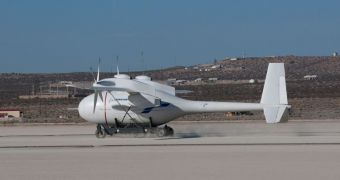A hydrogen-powered aircraft designed to conduct unmanned, long-range flights has successfully concluded its first, medium-speed taxi test at the Edwards Air Force Base (EAFB), in California. The vehicle is being developed by the Boeing Company.
The achievement brings the corporation one step closer to the first test flight. This aircraft, called the Phantom Eye, is of an innovative design, and features an unconventional power source. There aren't many unmanned aerial vehicles (UAV) in existence today that use hydrogen as fuel.
According to a Boeing press release, the main applications Phantom Eye will be used for revolving around persistent intelligence, surveillance and reconnaissance (ISR), and communications. This means that the UAV will essentially be a spy aircraft, capable of surveying enemy territory over a long time.
The taxi test was a collaboration between Boeing, the EAFB, and the NASA Dryden Flight Research Center, and was conducted on March 10. The vehicle managed to reach a speed of 30 knots, while traveling on a runway atop its launching cart system.
Commands were relayed to the Phantom Eye using Boeing's new, Common Open-mission Management Command and Control (COMC2) software. “The aircraft performed well and the data collected will help populate our models,” Drew Mallow explains.
“This test brings us one step closer to our first flight,” concludes the Boeing Phantom Eye program manager. He adds that the aircraft will be able to carry 450-pound (204-kilogram) payload for periods of time spanning up to 4 days.
Its wingspan exceeds 150 feet (45 meters), a trait that enables it to reach and maintain altitudes of up to 65,000 feet (19,812 meters). These specifications, alongside its unusual fuel, make the Phantom Eye a unique UAV to operate.
“Phantom Eye’s hydrogen-powered propulsion system, matched with its exceptional fuel economy and robust endurance, ushers in a new realm of possibilities for potential customers’ long-endurance ISR missions,” James Dodd explains.
The Boeing Phantom Works official is the vice president of the Advanced Boeing Military Aircraft division at the company.

 14 DAY TRIAL //
14 DAY TRIAL //